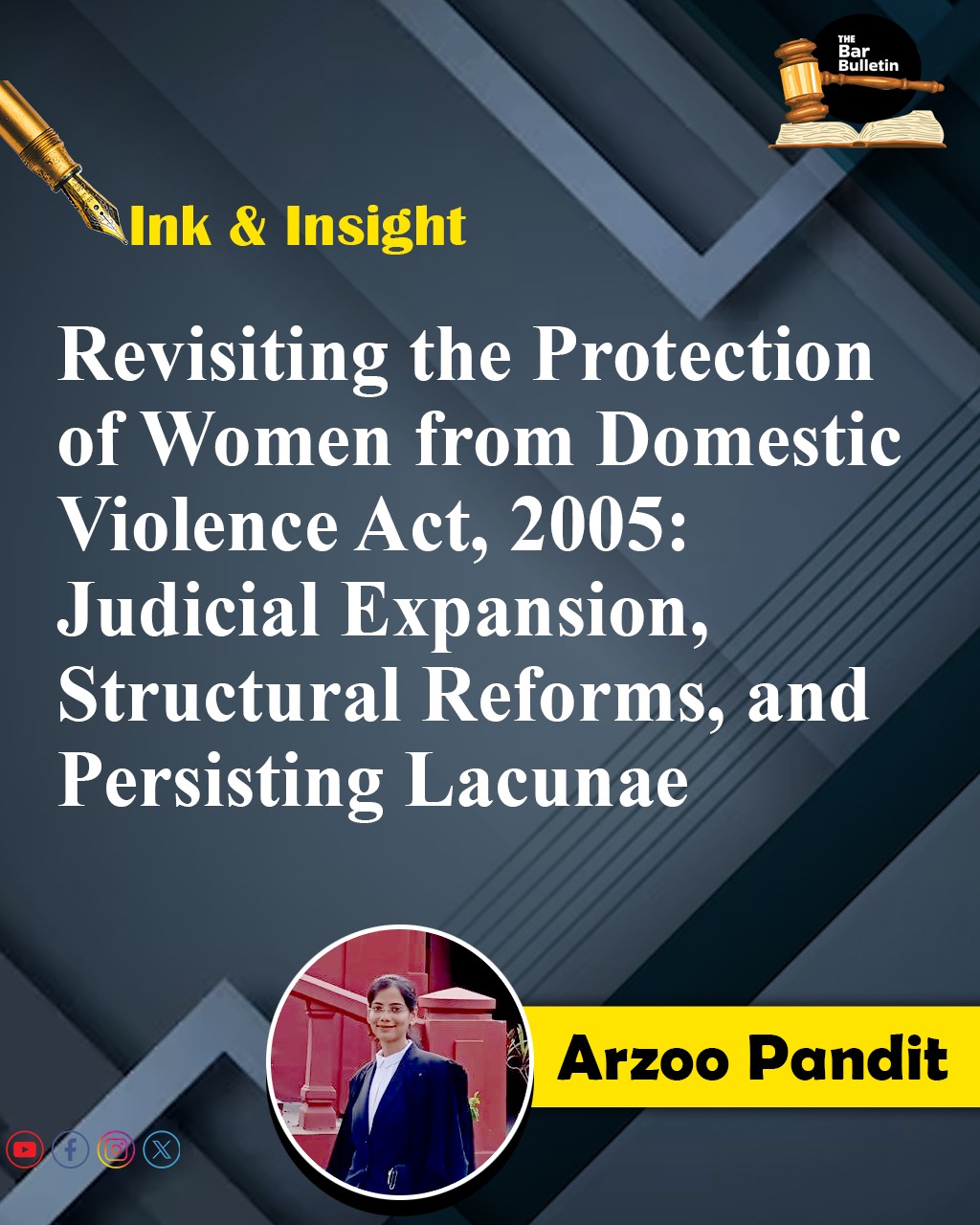Abstract
The Protection of Women from Domestic Violence Act, 2005 (PWDVA) was designed as a civil remedy to counter domestic violence beyond the limits of criminal law. Two decades on, the statute has evolved through expansive judicial interpretation and reinvigorating structural reforms but significant implementation gaps persist. This article examines the Act’s trajectory, focusing on pivotal judgments such as its extension to live-in relationships, removal of gendered restrictions, and recognition of widows’ rights. It analyzes the Supreme Court’s May 20, 2025 directives mandating state-level compliance on Protection Officers, shelter identification, and legal aid, along with Bihar’s institutional commitment and the June 2025 Kerala High Court ruling (Chenthamara @ Kannan & Ors. v. Meena) upholding a widow’s right to residence. Comparative perspectives from the U.K., U.S., and South Africa offer actionable models in enforcement mechanisms. Though legal frameworks are becoming more robust, their impact is hindered by poor staffing, infrastructural deficits, judicial delays, and entrenched social attitudes. The article argues that realizing the PWDVA’s promise requires sustained institutional investment and cultural transformation.
I. Introduction
The Protection of Women from Domestic Violence Act, 2005 (PWDVA) marked a watershed moment in Indian law by recognizing domestic violence as a civil rights violation with remedies like residence orders, protection orders, custody, and monetary relief extending protections well beyond the scope of Section 498A of the IPC.
II. Evolution Through Judicial Interpretation
In Indra Sarma v. V.K.V. Sarma, the Supreme Court held that women in “relationships in the nature of marriage,” including live-in relationships, are covered under the Act.[1]
In Hiral P. Harsora v. Kusum Narottamdas Harsora, the Court removed the term “adult male” from Section 2(q), expanding the list of possible respondents to include female relatives.[2]
In Ajay Kumar v. Lata @ Sharuti, the Court ruled that courts should not withhold interim relief pending reconciliation.[3]
These rulings reflect the judiciary’s commitment to a purposive and inclusive interpretation of the law.
III. Recent Developments
A. Supreme Court Directions, May 20, 2025
In We the Women of India v. Union of India, the Supreme Court issued seven directives requiring, within six weeks, the appointment of Protection Officers at district and taluka levels; publicity of the Act’s provisions (especially free legal aid); and within ten weeks, identification and notification of shelter homes and service providers.[4]
B. Bihar’s Administrative Response
Following the Court’s ruling, Bihar’s cabinet approved the appointment of 390 full-time Protection Officers across its districts and subdivisions—an unprecedented institutional expansion.[5]
C. Kerala High Court on Widows’ Rights
In Chenthamara @ Kannan & Ors. v. Meena, Crl. R.P. No. 286 of 2018, the Kerala High Court reaffirmed that a widow remains an “aggrieved person” under Section 17 and cannot be evicted from her matrimonial home post the husband’s demise.[6]
D. Legislative Supplements at State Level
Tamil Nadu enacted the Women’s Safety and Protection Act, 2025, providing one-year protection orders against stalkers, with penalties including imprisonment up to three years and fines illustrating evolving state-level approaches.[7]
IV. Comparative Perspectives
United Kingdom (Domestic Abuse Act, 2021): Includes Domestic Abuse Protection Notices and Orders and mandates local authority duty to provide safe accommodation.[8]
United States (Violence Against Women Act, 1994/2022): Incorporates federal funding for coordination, shelters, and legal aid across jurisdictions.[9]
South Africa (Domestic Violence Act, 1998): Obligates police officers to assist victims with protection orders and medical treatment; recent reforms include streamlined applications.[10]
These models highlight the effectiveness of centralized enforcement, specialized courts, and institutional support areas where India’s PWDVA could evolve further.
V. Persisting Lacunae
Despite progress, the PWDVA faces significant challenges:
1. Many Protection Officers remain overburdened with non-core responsibilities.
2. Shelters and service providers are rare and often under-resourced.
3. Reliefs intended to be prompt continue to face procedural delays.
4. Awareness of the law remains low in rural and marginalized communities.
5. Patriarchal social norms continue to deter women from seeking help.
VI. Conclusion
The PWDVA, 2005 remains one of India’s most progressive laws on women’s rights. Recent jurisprudence and directives including the Supreme Court’s active intervention in May 2025 and Kerala’s widow-residence recognition demonstrate renewed momentum. Still, law without implementation remains symbolic. To translate legal protections into lived realities, India must invest in dedicated institutional infrastructure, public awareness, judicial reform, and cultural transformation. Only then can every woman’s right to live without violence be meaningfully upheld.
*Advocate, Madhya Pradesh High Court, Indore
[1] Indra Sarma v. V.K.V. Sarma, (2013) 15 SCC 755 (India).
[2] Hiral P. Harsora v. Kusum Narottamdas Harsora, (2016) 10 SCC 165 (India).
[3] Ajay Kumar v. Lata @ Sharuti, (2019) 15 SCC 352 (India).
[4] We the Women of India v. Union of India, W.P. (C) No. 1156/2021 (Supreme Court of India, May 20, 2025) (bench of Justices B.V. Nagarathna & S.C. Sharma directing designation of Protection Officers, Section 9 representation, Section 11 outreach, free legal aid, and shelter home notifications) see 2025 announcements reports.4
[5] “Cabinet Approves 390 Protection Officer Posts to Tackle Domestic Violence,” Times of India (June 2025).
[6] Chenthamara @ Kannan & Ors. v. Meena, Crl. R.P. No. 286 of 2018 (Ker. H.C. June 2025) (Justice M.B. Snehalatha holding widow cannot be evicted from matrimonial home) see official high court judgment and media reports.6
[7] Women’s Safety and Protection Act, 2025 (Tamil Nadu, India).
[8] Domestic Abuse Act 2021, c. 17 (U.K.).
[9] Violence Against Women Act, 42 U.S.C. §§ 13701–40707 (U.S.).
[10] Domestic Violence Act 116 of 1998 (S. Afr.).


One thought on “Revisiting the Protection of Women from Domestic Violence Act, 2005: Judicial Expansion, Structural Reforms, and Persisting Lacunae”
Excellent and informative Work Adv. Arzoo Pandit